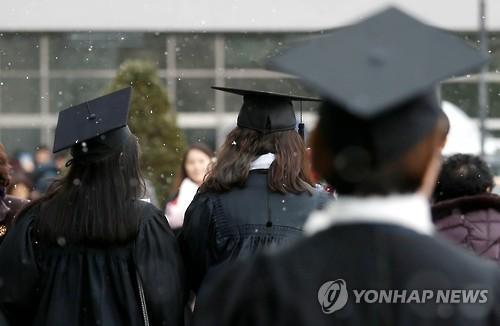The number of Korean university graduates giving up on looking for a job or not working at all has continued to increase, data showed Monday, highlighting bleak job prospects for young people.
According to Statistics Korea, the economically inactive population holding a university degree stood at 3.34 million last year, up 4.7 percent from a year earlier.
 |
| (Yonhap) |
The number of economically inactive university graduates who are neither employed nor have lost a job has more than doubled from 1.59 million in 2000. It broke the 2-million mark in 2004 and 3-million milestone in 2013.
The economically inactive population refers to those who are not looking for a job, are unable to work or do not want a job. It includes people who could be suffering from illness or disability, those studying full-time without a part-time job and those looking after young children or the elderly at home.
The highly educated accounted for 20.8 percent of the entire economically inactive population, which stands at 1.6 million, up 0.7 percent from the previous year during the same period.
The unemployment rate for youths aged between 15 and 29 was 9.2 percent last year, up 0.2 percentage points from a year earlier, making the highest in 16 years. Of this porportion, the unemployed among university degree holders increased by 0.1 percentage point to 3.6 percent.
The employment rate is the proportion of all people aged between 16 and 64 who are in work, while the unemployment rate is the number of people who are unemployed divided by the economically active population.
But an official from the Ministry of Labor and Employment told The Korea Herald that the job situation for the young is as not bad as it looks.
“It is a predictable result of the population growth, especially those highly educated,” he said. “Also, the employment rate for the young rose at the same time as the unemployment rate. It means that in Korea’s economic context, the young are highly educated, and they struggle to find a job that lives up to their expectation.”
Among the economically inactive population with university degrees, the number of those not entering the labor force but instead taking private classes to prepare themselves for better jobs stood at 609,000, a rise of 8 percent from a year earlier.
“The young prepare themselves for better-paid jobs rather than taking any job now. The problem is a mismatch in supply and demand for jobs,” he said. “So the government should focus on raising the quality of jobs.”
Since 2000, both the youth population and those receiving university degrees have also risen.
The population aged 15 and over was 7,031,000 in 2000, but it more than doubled to 15,121,000 last year. The number of those who had secured a job soared from 5,209,000 in 2000 to 11,351,000 in 2015, according to government data.
But the job market doesn’t look rosy this year, with the government data indicating that 91.4 percent of enterprises with more than 300 staff members will not recruit any employees.
Kim Jong-jin, a fellow research for Korea Labor and Society Institute, pointed out that the government should take the situation more seriously. The increase in the economically inactive population could mean the rise in the number of people involved in irregular employment, he said.
“The figures mean that there are more people not entering the official job market, not signing contract, getting under-the-table jobs, which cannot be calculated by the government,” he said. “It will reduce tax revenues, which will in turn cut back on welfare benefits for the poor.”
“The government should not only focus on boosting employment rate, but also should take a closer look at the changing job market structure that further disadvantages those on the edge of the society like the young, women and elderly.”
By Ock Hyun-ju (laeticia.ock@heraldcorp.com)

